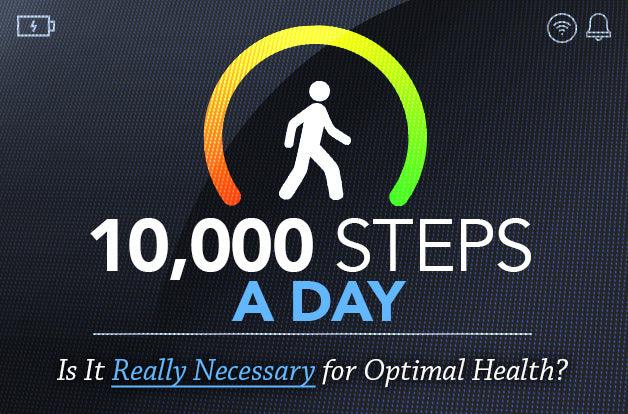Ten thousand steps a day — it’s a benchmark ingrained in the minds of millions of people. You may have jumped on the bandwagon at some point, going up a few extra flights of stairs or taking another walk around the block to hit that magical number. There’s no doubt that walking provides enormous benefits to the body, such as enhanced circulation, increased cardiovascular fitness, and facilitating the health of all the cells in your body by delivering critical nutrients to them, says Dr. Bill Rawls, Medical Director of Vital Plan. But is this daily milestone based on scientific evidence?
Below, we’ll discuss the history behind 10,000 steps per day and look at what the science says. Plus, we’ll dig a little deeper to discover how different exercise strategies could be incorporated into your daily life and improve your overall health and wellness. In the end, you may just find it’s time to ditch the obsession with the number “10,000” and reroute your focus to other activities instead.
How 10,000 Steps Became the Magic Number
The 10,000-step mark is the default setting on most of our health tracking devices; think of the fireworks or congratulations notification on your tracker when you achieve this milestone. And it’s the motivation behind countless competitions among friends and coworkers — not to mention the competitions we have with ourselves.
But it may surprise you to learn the concept of striving to hit 10,000 steps per day was thought up as part of a Japanese marketing strategy back in 1965, when the Manpo-kei (translation: 10,000 steps meter), the world’s first commercial pedometer, hit the market. It’s clear to see this marketing tactic worked, as getting 10,000 steps per day has become deeply embedded in cultures across the globe and synonymous with a healthy lifestyle.
And while the initial concept was rooted in clever marketing instead of science, the perks to anyone partaking in this daily challenge have been there all along: Walking can provide short- and long-term health advantages to the body. Reducing high blood pressure, decreasing the risk of type 2 diabetes, and maintaining a healthy body weight are just a few of the positive effects that can come from simply walking, says Dr. Rawls.
So, How Many Steps Do We Really Need?
While attaining 10,000 steps per day may be an achievable goal for some people, for others, factors like chronic health conditions, physical environment, and hectic schedules might make it a difficult number to reach consistently. The good news: The benefits of walking, and exercise in general, may be accomplished with far fewer steps.
Case in point: In 2019, Dr. I-Min Lee, an associate epidemiologist, Harvard Medical School professor, and physical activity researcher, conducted a large-scale study on more than 16,000 women with an average age of 72 years to discover the actual number of steps needed daily to reap health benefits and improve mortality rates.
The study participants wore a step-tracking device for a seven-day period to determine their daily step count, and they were re-evaluated 4.3 years later. The results? The women who walked an average of 4,400 steps per day saw a 41% decrease in mortality during the four-year time span compared to those who averaged 2,700 steps per day. Furthermore, the mortality rates continued to improve the more steps each woman took, however, the benefits maxed out at the 7,500-step mark.
Additionally, a smaller study examined the correlation between steps in middle-aged men and women and showed similar results: Taking 7,000 steps or more decreased mortality rates as compared to those who took less than 7,000 steps per day — lending some science-backed credence to the idea that the number of steps you take in a day can make a difference in your health and longevity, even if you don’t make it all the way to 10,000.


The advantage of walking is that it’s a low-impact and cost-effective exercise, plus there are several ways to get moving and have fun while doing it. YouTube offers a wide variety of at-home fitness routines. For example, Walk At Home is one of the platform’s most popular (and free) series that offers over 200 walk-at-home workouts that can help you achieve 1 to 3 miles of walking steps in the comfort of your own space.
Beyond Walking
But what if logging your step count isn’t practical or your preferred method of exercise? How, then, do you gauge how much exercise you need to benefit your overall health?
Adults should aim for 150 minutes of moderate-intensity physical activity per week to experience health benefits, according to the Centers for Disease Control and Prevention (CDC). Activities can be divided into smaller blocks of time throughout the week (for example, 30 minutes five days a week).
The CDC has also broken down weekly physical exercise milestones, depending on your age group and health status. These targets include:
- Ages 18 – 64: At least 150 minutes a week of moderate-intensity activity and at least two days a week of activities that strengthen muscles. “Moderate-intensity” exercise includes activities that raise your heart rate and may cause you to sweat, such as dancing, riding a bike, mowing the lawn, using an elliptical machine, practicing yoga, and more.
- Ages 65 and older: At least 150 minutes a week of moderate-intensity activity, at least two days a week of activities that strengthen muscles, and certain activities to improve balance (such as standing on one foot).
- Pregnant and postpartum women: At least 150 minutes of moderate-intensity aerobic activity a week.
- Adults with disabilities or chronic conditions: At least 150 minutes of moderate-intensity aerobic physical activity a week and at least two days a week of muscle-strengthening activities that include all major muscle groups.
Ultimately, “It’s more important to be continually active throughout the day and not focused solely on a number,” says Dr. Rawls. “Any activity that moves our blood, generates endorphins, reduces stress levels, normalizes hormones, and improves focus and concentration is beneficial and can really add up.” Even daily chores like mopping, vacuuming, and picking up a room can have value as exercise.
While the 10,000-steps-a-day craze may have just been one heck of a marketing ploy, there’s no denying it has profoundly motivated people for decades to increase their daily movement. But perhaps the key to moving forward and making lasting, healthy changes in our lives isn’t whether or not we hit the 10,000-step benchmark, but rather, how we can make room for daily movement, elevate our heart rates, and get that blood flowing, even if it’s just a few minutes at a time.
 Marisa Zeppieri is a freelance journalist and author of Chronically Fabulous, a memoir about thriving despite chronic illness. She is also the founder of the nonprofit and social community, LupusChick. Marisa lives in New York with her family and rescued terrier, Bogey.
Marisa Zeppieri is a freelance journalist and author of Chronically Fabulous, a memoir about thriving despite chronic illness. She is also the founder of the nonprofit and social community, LupusChick. Marisa lives in New York with her family and rescued terrier, Bogey.
natascha

Discover more in Dr. Bill Rawls' new #1 Bestselling book: The Cellular Wellness Solution: Tap Into Your Full Health Potential with the Science-Backed Power of Herbs.
"An eye-opening and empowering book that the world needs right now: The Cellular Wellness Solution will fundamentally change how you think about herbs and the powerful role they play in cultivating wellness at the cellular level."


Mark Hyman, MD
Fourteen-time #1 New York Times Bestselling Author
Looking for More Wellness Tips?
Join our newsletter for bi-weekly tools, education, and savings to boost your health.
References
1. Fortes C, Mastroeni S, Sperati A, Pacifici R, Zuccaro P, Francesco F, Agabiti N, Piras G, Amleto D, Ebrahim S. Walking four times weekly for at least 15 min is associated with longevity in a cohort of very elderly people. Maturitas. 2013 Mar;74(3):246-51. doi: 10.1016/j.maturitas.2012.12.001
2. How much physical activity do adults need? Centers for Disease Control and Prevention website.
https://www.cdc.gov/physicalactivity/basics/adults/index.htm
3. Lee IM, Shiroma EJ, Kamada M, Bassett DR, Matthews CE, Buring JE. Association of Step Volume and Intensity With All-Cause Mortality in Older Women. JAMA Intern Med. 2019 Aug 1;179(8):1105-1112. doi: 10.1001/jamainternmed.2019.0899
4. Paluch AE, Gabriel KP, Fulton JE, Lewis CE, Schreiner PJ, Sternfeld B, Sidney S, Siddique J, Whitaker KM, Carnethon MR. Steps per Day and All-Cause Mortality in Middle-aged Adults in the Coronary Artery Risk Development in Young Adults Study. JAMA Netw Open. 2021 Sep 1;4(9):e2124516. doi: 10.1001/jamanetworkopen.2021.24516
5. 10,000 steps a day — or fewer? Harvard Health Publishing. https://www.health.harvard.edu/blog/10000-steps-a-day-or-fewer-2019071117305
6. Wisdom of the Cell. Harvard Medical School. https://hms.harvard.edu/news/wisdom-cell



